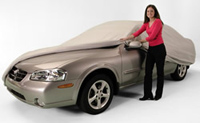
Car Covers: Why Women Should Care
By Linda Morgan
Isn't
she lovely? Beautiful body, impeccably outfitted, polished
to a high gleam. Your car looks good, and you know how
good you look behind the wheel.
 |
Car Covers keep your car looking great |
So you're devoted to its care, up-to-date maintenance
records, oil changes right on schedule, washed (and
waxed) religiously. You know your car is an investment
and you manage it as closely as you do your portfolio.
But have you thought about providing for the long-term
beauty of your car with a car cover?
Once
the domain of the automotive enthusiast, car covers
are increasingly becoming de rigueur for the non-obsessive
set. Why? Because, simply, they protect your investment
against everything from acts of nature to acts of man.
Environment:
Neither heat nor shade nor acid rain is good for a car's
finish -
So
much of nature's beauty is dangerous to your car's youthful
glow. Years of engineering go into the fabrics that
make up car covers, resulting in products that keep
cars drier, cleaner and safer from harm caused by:
-
Trees — In the heat of August, nothing looks quite so inviting
as that open parking spot in the shade. But trees
can wreak havoc with your paint job. First of all,
there's sap to deal with. Even small drops of sap
can produce permanent color changes and can etch your
paint. Pinesap is particularly dangerous, as it contains
turpentine, hardly a friend of paint.
-
Birds,
nuts, berries — Bird droppings are similarly toxic.
And if that's not enough, acorns, pinecones, branches,
and other things that fall out of trees can cause
tiny chips in the paint, allowing moisture to creep
in and do its dirty work. The right car cover can
block these forms of debris.
-
Sunshine — Parking in the sun isn't a safe option, either.
Ultraviolet rays and radiant energy — also known as
heat — have a pronounced effect on automobile finishes.
Paint colors can not only fade, but are likely to
fade unevenly, over time; if you park in the same
spot every day, the same side of your car is always
facing south. UV rays can slowly erode sections of
that beautiful finish.
Your interior isn't faring too well in the sun, either.
Trapped heat can dry out and deteriorate vinyl, leather,
plastic and rubber. It bakes and breaks down foam
padding and adhesives; it cooks audio components,
tapes and disks. And it gets a little worse every
year, as the ozone layer diminishes.
Fortunately, the best car cover fabric manufacturers
are devoting a significant amount of research to understanding
the effects of UV rays, and designing covers that
not only will block them from your car, but also withstand
the UV exposure.
-
Rain — While an occasional rainstorm won't destroy your car's finish, the process of corrosion begins any time your car has exposed blemishes and is subjected to very moist conditions. Moisture seeps into tiny cracks and dings and begins to works against your paint from the inside out by separating the paint from the metal, causing the metal to oxidize.
And that's nothing compared to acid rain, which occurs when sulfur and nitrogen oxides are released into the environment as industrial pollutants. The bad news is that, once they're in the atmosphere, they are converted chemically into secondary pollutants — nitric acid and sulfuric acid. In some parts of the country, acid rain can rival vinegar or lemon juice in acidity.
To understand how dangerous that can be, consider that leading archaeologists are concerned that acid rain is eating away at ancient Mayan ruins. If it can destroy something built to last for centuries, just think what it's doing to your paint.
The best covers block heavy rain and sleet, while allowing any moisture vapor that's already trapped to escape.
-
Winter — Once it turns cold, new hazards come around to attack your car. If tough winter weather doesn't get to your car, the things we do to deal with the weather will. There are two corrosive culprits associated with ice and snow — moisture and salt. The same moisture that hurts your car as rain produces similar damage as snow and ice. And then the salt that lets you drive more safely in winter road conditions accelerates the corrosive process by slowing down drying times and causing a chemical reaction with the metal body of your car.
Proximity hazards: At home or away
So it would be simpler — and just as effective — to skip the car cover and park in a covered garage, right? Wrong.
There are plenty of other threats capable of harming a car inside:
-
Dents and scratches — Most everyone is familiar with the feeling that comes from finding the first dent, ding or scratch on a new car. Unfortunately, dings happen; only a protective suit of armor — or a cover — can help protect your car from impatient drivers and imperfect parkers by adding a layer of padding to help absorb some of the blows.
-
Dust — At the other extreme, dust is similarly damaging. Even if you park inside, dust settles on the car's surface, building up a layer of grit that eventually turns abrasive. Though it may produce only minute scratches at first, your car's paint is only about 0.006 inches thick and will eventually begin to dull and show signs of wear. By the time you've noticed it, it's too late.
On the interior, dust and grit can abrade fibers, causing them to wear through and break. Even the moist dirt and debris that you bring in on your shoes can promote mold and mildew growth inside a closed-up car. Creating a barrier to dust isn't as easy as putting a cloth on the car. The fibers in good car covers keep out more dust-a fact not lost on car enthusiasts.
-
Theft — With all the new high-tech theft-deterrent devices out there, it's easy to forget that a simple car cover can protect your vehicle from thieves.
Think about it: A thief knows that his risk of getting caught increases with every passing minute. As he works to gain entry to the car, he is exposed. The average thief will bypass a covered car for an easier target. Of course, covers are not a replacement for locks and alarms; they simply augment these protective devices. But a cover can also deter theft by masking the car's make and model — as well as stereo equipment, cellular phones and other items — from criminals.
Dispelling the myths about car covers
After that list of potential hazards, it's fairly obvious that the best time to use a cover is anytime you're not driving the car. Like the exercise equipment-turned-clothes-rack, a cover is a great thing to have, but won't do any good if you don't use it. So do people really use car covers? And aren't they a pain to put on and take off? Especially for women, who are typically not as strong as men.
According to a recent survey of real users conducted by Kimberly-Clark, that perception is not reality. When asked about the ease of putting on and taking off their car covers, nearly 80 percent of current owners said it was easy. Sixty percent were satisfied with the purchase of a cover, and more than 90 percent said they would purchase one again. Covers also receive high marks in customer satisfaction-from women drivers, too (see sidebar below).
Of course it pays to be careful. For women in particular, car covers are not always good options in unfamiliar or unsecured parking areas, where getting in your car and locking your doors as soon as possible should be priority one. But then again, those aren't the best places to park in the first place.
Choosing a car cover
When it comes to car covers, one size does not fit all-literally and figuratively. But that doesn't mean choosing a car cover has to be difficult. It simply means asking yourself a few questions:
-
What are you trying to protect your car against?
Most car covers can keep out a reasonable amount of dirt, but some are specially designed to block UV rays, dust and water. If the car has an especially delicate paint job, the interior softness of the cover becomes an issue.
-
How, where and when are you going to use the cover? Is your car housed in a garage? Or outdoors most of the time? Or do you travel a lot and need to cover your car while at the airport? Ease-of-use, how the cover handles in the wind and the space required to store it are all factors to consider.
-
How much do you want to spend?
Car covers range in price. Usually the price depends on whether it's a custom-fit cover (model-specific) or a universal one (S, M, L or XL). However, price also depends on what the cover is designed to do and how much protection the fabric offers. Automotive
catalogs (both print and Internet), automotive dealerships,
and car-related stores carry specialty covers custom-made
for specific car makes and models. These covers are
tailored to the car's shape — more like custom upholstery than slipcovers.
Beauty is more than skin deep
As you may have guessed thus far, not all car covers are created equal. Some can keep just about anything out, others protect a lot less and still others are worse than nothing at all. A car cover's level of protective performance depends on one key factor — Fabric
Some woven fabrics keep out rain, but trap condensation underneath. Some allow air to circulate, but they also let rain in. Others become brittle in cold weather and deteriorate rapidly when exposed to UV rays or pollution. And wovens are so thin they provide little protection against impacts that cause nicks, dings and scratches. Truth is, most woven fabrics were never designed for car cover use.
Nonwoven fabrics are a different story. The nonwovens used for car covers are basically strands of polymers (polyolefins) formed into fabrics held together using heat (thermal bonding) or adhesives. These innovative fabrics breathe (allowing moisture trapped under cover to evaporate) and block heat and damaging UV rays from the sun. A lot of science goes into the development of a good cover.
With a little care, you can keep "your baby" looking great for a long time. If you've never used a car cover, it's time to think about it. If you have, it's time to think about it again. The best of today's car covers are easier to deal with and better than ever. But their value is the same: protecting your car's finish and keeping it looking its best for a long time to come.
Car Covers: One Woman's Story |
 Simone DuBois knows the value of a car cover because she learned the hard way. She places the value at about $3,000, because that's what not using her car cover cost her. Simone DuBois knows the value of a car cover because she learned the hard way. She places the value at about $3,000, because that's what not using her car cover cost her.
"There were only two times I didn't cover my car," a 1975 530E BMW outfitted for the track, says Simone, a computer designer in Alpharetta, Ga. "And both times, someone broke in and ripped out the CD player with a crowbar!"
After buying two new CD players, replacing a rear window and chrome window trim, making console repairs and paying for rental cars, she's now a car cover advocate.
"I bought that first cover, a custom one, almost 10 years ago because I wanted to protect the car's finish at home-where it was parked outside--and at the airport, because I traveled a lot," she said. "But that cover protected a lot more than the paint job."
These days, Simone has two cars...and two car covers. The BMW is still with her — covered all the time. But she drives a 1986 Corvette, which she keeps covered, even in the garage, and definitely at the airport.
"When I park at the airport, I always cable and lock the cover. A flick of the wrist, a walk around the car, and voila! The cable hooks in right below the grommet," she said. "Contrary to popular belief, they're not at all difficult to put on and take off. All you have to do is put the cover on and take it off the same way each time. You fold it so ends up as a square that you just pop in the trunk."
"I'd recommend a car cover to anyone who cares about her car. The protection it provides against theft, dents and dings is well worth the little bit of effort required to use it...and I like driving a really clean car." |
About the author: Linda Morgan is a research scientist in the Nonwoven Fabrics Division of Kimberly-Clark Corporation, producers of BLOCK-IT® Fabrics, the leading line of protective car-cover fabrics. For more information visit www.block-it.com. |